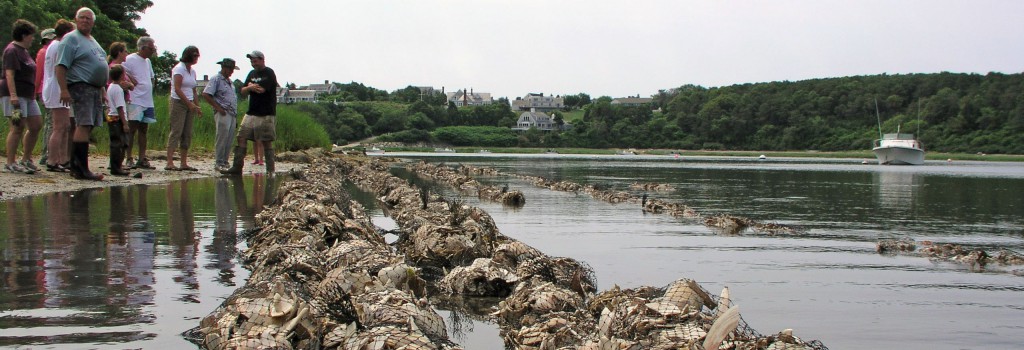Sustainable Fisheries and Aquaculture
2024-2025 Projects
» Caroline Ummenhofer, Svenja Ryan, and Glen Gawarkiewicz of Woods Hole Oceanographic Institution: Changing Currents: Collecting data with fishermen to build more sustainable fisheries
2022-2023 Projects
» Andy Danylchuk and Lucas Griffin, University of Massachusetts Amherst: Stripers on the Line: Quantifying short-term post-release activity, behavior and mortality of striped bass (Moronesaxatilis) in the Massachusetts recreational fishery
» Dr. Torrance Hanley of Northeastern University and collaborators: Determining How Aquaculture Grow-Out Methods Can Reduce the Negative Effects of Parasites and Micropollutants
» Jesús Pineda, Carolyn Tepolt, and graduate student Jane Weinstock of the Woods Hole Oceanographic Institution: Barnacle Biofouling on Oyster Farms: Species-specific seasonal timing and population connectivity
2020-2022 Projects
» Adrian Jordaan, University of Massachusetts-Amherst, and Michelle Staudinger and Allison Roy, U.S. Geological Survey: Closing the loop: characterizing habitat requirements, movements, and life stage linkages of river herring in Massachusetts watersheds
» Jordan Pitt, Mark Hahn and Neel Aluru, Woods Hole Oceanographic Institution: Microplastics in coastal marine animals: Defining the problem
» Scott Gallager and Jim Churchill, Woods Hole Oceanographic Institution: Assessing the Seasonal and Storm-Impacted Transport and Biological Fate of Micro- and Nanoplastics Discharged from Wastewater Treatment Facilities into Massachusetts Coastal Waters
2018-2020 Projects
» Joel Llopiz and Rubao Ji, Woods Hole Oceanographic Institution, Martha Hauff, Stonehill College, and Hannes Baumann, University of Connecticut: Source-sink dynamics and habitat modeling of northern sand lance on Stellwagen Bank and Nantucket Shoals
» Di Jin, Porter Hoagland, and Hauke Kite-Powell, Woods Hole Oceanographic Institution: Valuation of ecosystem benefits of living shorelines
» Jefferson Turner, University of Massachusetts Dartmouth:
Harmful phytoplankton blooms in Buzzards Bay, Mass.
2016-2018 Projects
» Daniel Rogers (Stonehill College) and Virginia Edgecomb (Woods Hole Oceanographic Institution): Understanding the impact of floating oyster aquaculture on the carbon and nitrogen flux to the sediments using natural abundance isotopic surveys and metagenomic approaches
» Michael Brosnahan, Don Anderson, Heidi Sosik, Rob Olson (Woods Hole Oceanographic Institution): Enhanced monitoring and spatial mapping of toxic algal blooms.
» Diane Murphy (Cape Cod Cooperative Extension), Read Porter (Roger Williams University), Rebecca Kihslinger (Environmental Law Institute) and Michael Tlusty (New England Aquarium): Creating a spatially defined tool for marine aquaculture siting and permitting
» Scott Lindell (Woods Hole Oceanographic Institution): Integrating mussel and kelp longline culture structures and management
2014-2016 Projects
» Jeannette Wheeler, Lauren Mullineaux, and Karl Helfrich, Woods Hole Oceanographic Institution: Behavioral responses of competent larval oysters (Crassostrea virginica) to chemical settlement cue in turbulent flow
» Joel Llopiz, Woods Hole Oceanographic Institution: Beyond fish passage: Variability in nursery habitat and its influence on the feeding, growth, and survival of the early life stages of river herring
» Roxanne Smolowitz, Roger Williams University, Hauke Kite-Powell, Woods Hole Oceanographic Institution, and John Brawley, Saquish Scientific: Research to inform regulatory decisions on the management of Vp in Massachusetts Shellfish growing areas (NSI Aquaculture Research)
2012-2014 Projects
» James Churchill, Woods Hole Oceanographic Institution, and Geoffrey Cowles, University of Massachusetts-Dartmouth: Modeling as a Tool to Better Understand Bay Scallop Recruitment and to Manage Bay Scallop Populations
» Scott Lindell, Marine Biological Laboratory, and Charles Yarish, University of Connecticut: Multi-Cropping Shellfish and Macroalgae for Business and Bio-Extraction
» Lauren Mullineaux and Meredith White, Woods Hole Oceanographic Institution: Transgenerational Exposure of Bay Scallops to Ocean Acidification
» Simon Thorrold and Joel Llopiz, Woods Hole Oceanographic Institution: Investigating Decadal-Scale Changes at the Base of the Georges Bank Food Web Through the Use of Compound-Specific Stable Isotope Analyses of Haddock Scales
2010-2012 Projects and Papers
» Magowan, K., Reitsma, J. and Murphy, D., Use of Dual-Frequency Identification Sonar to Monitor Adult River Herring in a Small Coastal Stream
Focus Area Summary
Woods Hole Sea Grant has identified the revitalization of our nation’s fisheries and sustainable aquaculture as priority areas that fit within the capacity of the academic and research environment within the region served by our program. It is our belief that these two priority areas are very closely linked technologically and culturally within New England and thus we are approaching these areas as a unified and coordinated effort. The program elements include:
- development of technology and programs to promote stock enhancement of natural fish and shellfish resources, including mechanisms to evaluate the efficacy of enhancement programs and the overall effectiveness of such programs;
- investigation of larval recruitment processes for fish and shellfish and development of means to understand the relationship between recruitment and physical and chemical characteristics of the environment;
- investigation of disease processes in marine organisms with an emphasis on prophylactics and management of diseased stocks to minimize economic losses to the natural fisheries and aquaculture industries; and
- promotion of business and industrial development through expanding efforts in coastal management and through understanding of the economics of marine related businesses.

